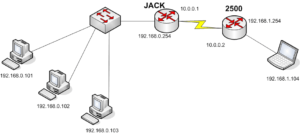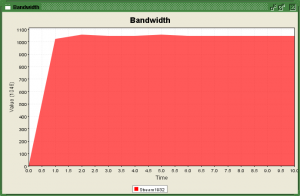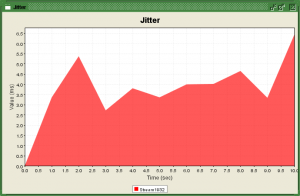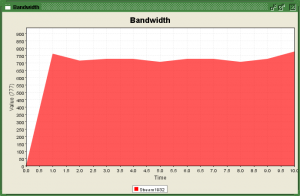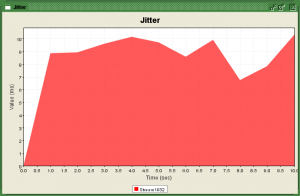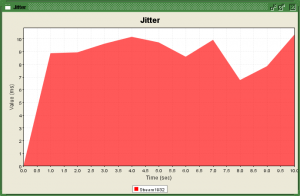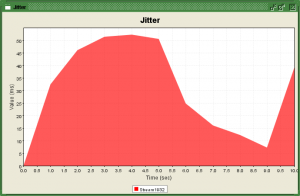Utilizziamo la Modular QoS CLI per garantire banda minima ai pc secondo il criterio IP più basso maggiore banda.
N.B. Utilizzando CBWFQ di default la somma delle bandwith allocate non deve superare il 75% della banda totale dell’interfaccia. Per modificare questo valore usare max-reserved-bandwidth [1-100]
Su JACK:
access-list 101 permit udp host 192.168.0.101 any access-list 102 permit udp host 192.168.0.102 any access-list 103 permit udp host 192.168.0.103 any class-map match-all pc101 match access-group 101 class-map match-all pc_103 match access-group 103 class-map match-all pc_102 match access-group 102 policy-map regole class pc101 bandwidth percent 30 class pc_102 bandwidth percent 20 class pc_103 bandwidth percent 10 interface Serial0 ip address 10.0.0.2 255.0.0.0 max-reserved-bandwidth 100 service-policy output regole
In questo caso ho assegnato solo un 60% della banda alle class-map e con il link seriale a 1544Mbit, questo vuol dire 618K di banda ancora disponibile, 40%, da assegnare come mostrato qui in seguito:
JACK#sh int s0
Serial0 is up, line protocol is up
Hardware is PowerQUICC Serial
Internet address is 10.0.0.2/8
MTU 1500 bytes, BW 1544 Kbit, DLY 20000 usec,
reliability 255/255, txload 1/255, rxload 1/255
Encapsulation HDLC, loopback not set
Keepalive set (10 sec)
Last input 00:00:06, output 00:00:02, output hang never
Last clearing of "show interface" counters never
Input queue: 0/75/0/0 (size/max/drops/flushes); Total output drops: 0
Queueing strategy: weighted fair
Output queue: 0/1000/64/0 (size/max total/threshold/drops)
Conversations 0/1/256 (active/max active/max total)
Reserved Conversations 3/3 (allocated/max allocated)
Available Bandwidth 619 kilobits/sec
Questo perché ho utilizzato max-reserved-bandwidth a 100.
Vediamo il caso standard, ovvero con il 75% del totale della banda assegnata, nel caso del link a 1.544Mbit, sarà di 1.158Mbit
JACK#sh int s0
Serial0 is up, line protocol is up
Hardware is PowerQUICC Serial
Internet address is 10.0.0.2/8
MTU 1500 bytes, BW 1544 Kbit, DLY 20000 usec,
reliability 255/255, txload 1/255, rxload 1/255
Encapsulation HDLC, loopback not set
Keepalive set (10 sec)
Last input 00:00:06, output 00:00:06, output hang never
Last clearing of "show interface" counters never
Input queue: 0/75/0/0 (size/max/drops/flushes); Total output drops: 0
Queueing strategy: weighted fair
Output queue: 0/1000/64/0 (size/max total/threshold/drops)
Conversations 0/1/256 (active/max active/max total)
Reserved Conversations 0/0 (allocated/max allocated)
Available Bandwidth 1158 kilobits/sec
5 minute input rate 0 bits/sec, 0 packets/sec
5 minute output rate 0 bits/sec, 0 packets/sec
1004 packets input, 61639 bytes, 0 no buffer
Received 965 broadcasts, 0 runts, 0 giants, 0 throttles
2 input errors, 0 CRC, 2 frame, 0 overrun, 0 ignored, 0 abort
1237 packets output, 112822 bytes, 0 underruns
0 output errors, 0 collisions, 57 interface reseti
La configurazione su JACK è la seguente:
access-list 101 permit udp host 192.168.0.101 any access-list 102 permit udp host 192.168.0.102 any access-list 103 permit udp host 192.168.0.103 any class-map match-all pc101 match access-group 101 class-map match-all pc_103 match access-group 103 class-map match-all pc_102 match access-group 102 policy-map regole class pc101 bandwidth percent 50 class pc_102 bandwidth percent 20 class pc_103 bandwidth percent 5 interface FastEthernet0 ip address 192.168.0.1 255.255.255.0 speed auto interface Serial0 ip address 10.0.0.2 255.0.0.0
N.B. Le prove seguenti sono state effettuate con JACK programmato come nel modo standard.
Sui ogni pc è stato installato iperf, reperibile qui.
Sul notebook sono state lanciate tre istanze del programma in modalità server per la ricezione di pacchetti UDP e in ascolto rispettivamente sulle porte 5001, 5002 e 5003 per accettare le tre connessioni client.
Sui PC è stata lanciata una sessione di iperf in modalità client secondo lo schema:
192.168.0.101 -> 192.168.1.4:5001
192.168.0.102 -> 192.168.1.4:5002
192.168.0.103 -> 192.168.1.4:5003
e impostato per generare 1Mbit di traffico UDP per un tempo di 10 sec.
Di seguito riportiamo i dati numerici e i grafici di banda e jitter dei singoli flussi udp.
PC1:
[1932] local 192.168.1.4 port 5002 connected with 192.168.0.101 port 1086 [ ID] Interval Transfer Bandwidth Jitter Lost/Total Datagrams [1932] 0.0- 1.0 sec 125 KBytes 1023 Kbits/sec 3.352 ms 1127103316/ 87 (1.3e+009%) [1932] 1.0- 2.0 sec 129 KBytes 1058 Kbits/sec 5.363 ms 0/ 90 (0%) [1932] 2.0- 3.0 sec 128 KBytes 1047 Kbits/sec 2.720 ms 0/ 89 (0%) [1932] 3.0- 4.0 sec 128 KBytes 1047 Kbits/sec 3.806 ms 0/ 89 (0%) [1932] 4.0- 5.0 sec 129 KBytes 1058 Kbits/sec 3.348 ms 0/ 90 (0%) [1932] 5.0- 6.0 sec 128 KBytes 1047 Kbits/sec 3.993 ms 0/ 89 (0%) [1932] 6.0- 7.0 sec 128 KBytes 1047 Kbits/sec 4.015 ms 0/ 89 (0%) [1932] 7.0- 8.0 sec 128 KBytes 1047 Kbits/sec 4.644 ms 0/ 89 (0%) [1932] 8.0- 9.0 sec 128 KBytes 1047 Kbits/sec 3.334 ms 0/ 89 (0%) [1932] 9.0-10.0 sec 129 KBytes 1058 Kbits/sec 5.900 ms 0/ 90 (0%) [1932] 0.0-10.0 sec 1282 KBytes 1046 Kbits/sec 6.437 ms 0/ 893 (0%)
PC2:
[1932] local 192.168.1.4 port 5001 connected with 192.168.0.102 port 1124 [ ID] Interval Transfer Bandwidth Jitter Lost/Total Datagrams [1932] 0.0- 1.0 sec 93.3 KBytes 764 Kbits/sec 8.853 ms 1127103316/ 65 (1.7e+009%) [1932] 1.0- 2.0 sec 87.6 KBytes 717 Kbits/sec 8.940 ms 0/ 61 (0%) [1932] 2.0- 3.0 sec 89.0 KBytes 729 Kbits/sec 9.593 ms 0/ 62 (0%) [1932] 3.0- 4.0 sec 89.0 KBytes 729 Kbits/sec 10.156 ms 15/ 77 (19%) [1932] 4.0- 5.0 sec 86.1 KBytes 706 Kbits/sec 9.717 ms 27/ 87 (31%) [1932] 5.0- 6.0 sec 89.0 KBytes 729 Kbits/sec 8.595 ms 28/ 90 (31%) [1932] 6.0- 7.0 sec 89.0 KBytes 729 Kbits/sec 9.909 ms 29/ 91 (32%) [1932] 7.0- 8.0 sec 86.1 KBytes 706 Kbits/sec 6.750 ms 26/ 86 (30%) [1932] 8.0- 9.0 sec 89.0 KBytes 729 Kbits/sec 7.844 ms 29/ 91 (32%) [1932] 9.0-10.0 sec 109 KBytes 894 Kbits/sec 10.207 ms 34/ 110 (31%) [1932] 0.0-10.4 sec 988 KBytes 777 Kbits/sec 10.337 ms 205/ 893 (23%)
PC3:
[1932] local 192.168.1.4 port 5003 connected with 192.168.0.103 port 1203 [ ID] Interval Transfer Bandwidth Jitter Lost/Total Datagrams [1932] 0.0- 1.0 sec 21.5 KBytes 176 Kbits/sec 32.374 ms 1127103316/ 15 (7.5e+009%) [1932] 1.0- 2.0 sec 21.5 KBytes 176 Kbits/sec 46.099 ms 0/ 15 (0%) [1932] 2.0- 3.0 sec 23.0 KBytes 188 Kbits/sec 51.364 ms 0/ 16 (0%) [1932] 3.0- 4.0 sec 21.5 KBytes 176 Kbits/sec 52.336 ms 0/ 15 (0%) [1932] 4.0- 5.0 sec 23.0 KBytes 188 Kbits/sec 50.489 ms 4/ 20 (20%) [1932] 5.0- 6.0 sec 21.5 KBytes 176 Kbits/sec 24.842 ms 71/ 86 (83%) [1932] 6.0- 7.0 sec 21.5 KBytes 176 Kbits/sec 16.016 ms 73/ 88 (83%)


